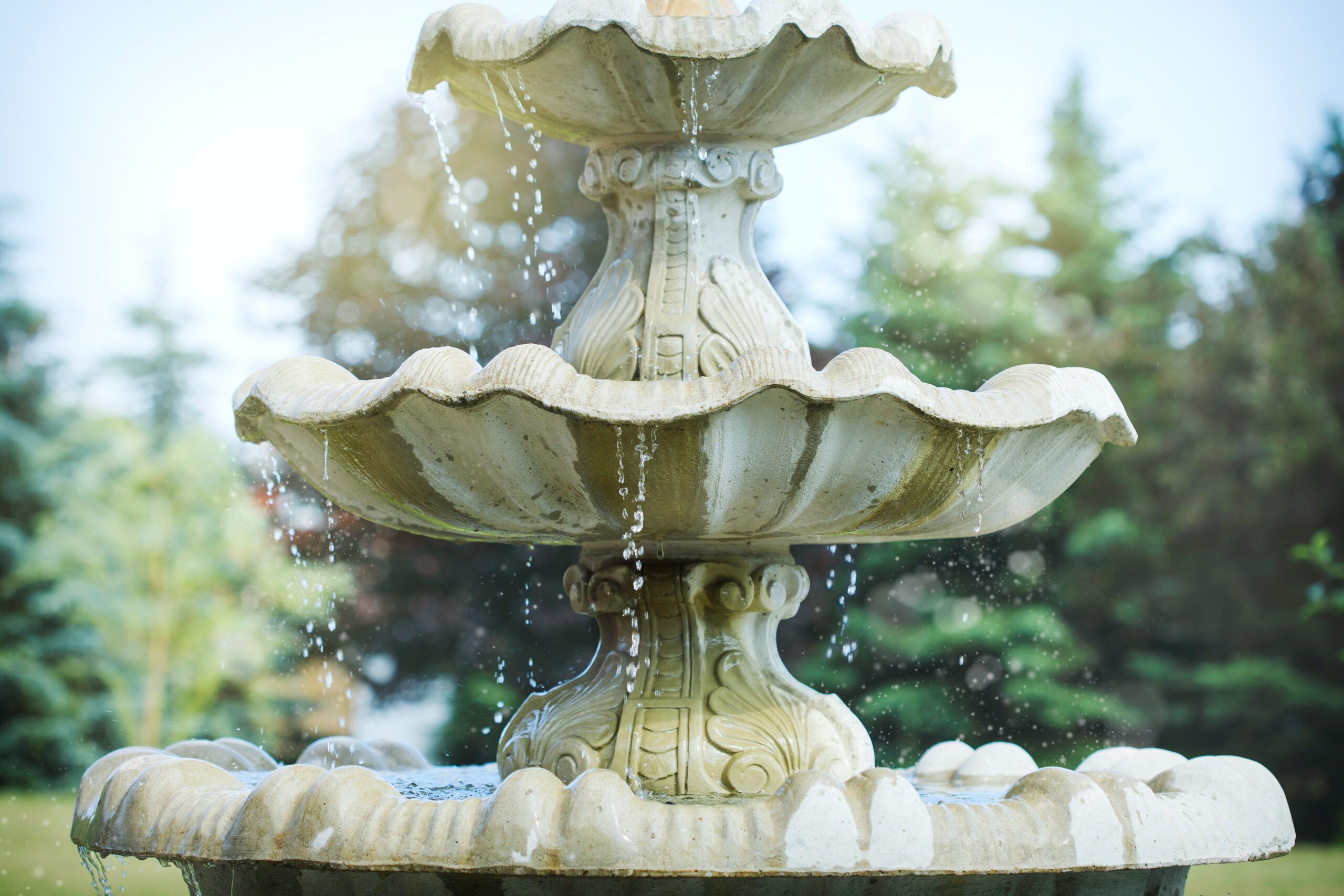Fountains are a serene landscaping feature, but they require regular attention and care to run smoothly. In this guide, we’ll cover everything from basic cleaning to winterization to make sure your fountain remains in top condition.
Components of a Fountain System
Knowing the components of your fountain system will help you maintain it more effectively. Most outdoor fountains consist of these components:
- Basin or reservoir
- Pump
- Tubing
- Fountain head or spout
- Decorative elements (such as statues or rocks)
Fountain Cleaning and Maintenance
Regular maintenance prevents the buildup of dirt, algae, and mineral deposits that can damage your fountain and affect its appearance.
Remove Grime
Dirt and debris accumulate quickly in outdoor fountains, especially during windy or stormy weather. Take these steps to keep your fountain clean:
- Drain the fountain once a month or as needed.
- Use a soft cloth or sponge to wipe down the interior surfaces.
- Use a mixture of vinegar and water with a soft-bristled nylon brush for stubborn buildup.
- Rinse thoroughly and refill with fresh water.
Remember to clean all surfaces, including hidden areas where algae and bacteria can thrive. Regular cleaning improves the fountain’s appearance, helps maintain water quality, and prevents pump damage.
Algae and Mineral Buildup
Algae and mineral deposits can be persistent problems in outdoor fountains. To combat these issues, follow these steps:
- Add a water clarifier to deter algae growth each time you refresh the water supply.
- Use a scale and stain remover to prevent mineral buildup, following the manufacturer’s dosage instructions.
- If algae or scale persists, double the normal amount of treatment products.
- In warmer months, when algae grow more, add a time-release algaecide tablet about once every three weeks.
Natural Algae Prevention Methods
Before resorting to chemical treatments, try these natural methods to prevent algae growth:
- Add aquatic plants that compete with algae for nutrients.
- Ensure proper water circulation by keeping your fountain running regularly.
- Place your fountain in a partially shaded area to reduce direct sunlight exposure.
- Use copper strips or pennies in the water, as copper has natural algae-inhibiting properties.
Maintain Fountain Water Levels
Low water levels can cause the pump to overheat and potentially fail. To prevent this, try the following:
- Check the water level daily, especially during hot or windy weather.
- Consider installing an auto-fill device for larger fountains or in areas with high evaporation rates.
- Top off the water as needed to keep the pump fully submerged.
Continuous operation can help prevent stagnant water and algae growth, but you should choose to monitor water levels closely if you choose to run your fountain 24/7.
Protect Your Fountain Pump
Protecting your fountain pump is important for maintaining your fountain’s performance.
Put on Stockings
A clever trick to protect your pump from debris is to use an old nylon stocking:
- Slip the stocking over the pump and its intake.
- Secure it in place with a rubber band or zip tie.
- Replace the stocking every few weeks or when it becomes clogged.
This simple hack acts as a prefilter, catching larger debris before it can enter and potentially damage your pump. It’s an easy and cost-effective way to extend your pump’s lifespan and maintain efficiency.
Prevent Pump Overheating
Overheating is a common reason for damaged or destroyed fountain pumps. To prevent this, try the following tips:
- Clean the pump regularly to remove any buildup that could impede water flow.
- Consider using a larger pump than necessary to reduce strain and heat buildup.
- Ensure the pump is always fully submerged in water.
- Place the fountain in a shaded area if possible to reduce water evaporation.
Winterize Your Outdoor Fountain
You should prepare your fountain for winter each year, or you’ll face costly repairs come spring.
Preparing for Cold Weather
As temperatures begin to drop, follow these steps to winterize your fountain:
- Drain the fountain completely, ensuring no water remains in the basin or tubing.
- Clean all surfaces thoroughly to remove any algae or debris.
- Dry all components to prevent frost damage.
- Disconnect and store the pump indoors.
- Cover the fountain with a waterproof cover designed for outdoor use.
Storage Tips for Removable Parts
For fountains with removable parts or those that disassemble:
- Clean and dry all parts before storage to prevent mold growth.
- Label parts and take photos to make reassembly easier in spring.
- Store fragile pieces in padded containers to prevent damage.
- Store smaller components in a dry, indoor location.
Troubleshooting Common Outdoor Fountain Issues
Even with regular maintenance, fountains can sometimes develop issues.
Unusual Noises
If your fountain starts making unusual noises, it could indicate:
- Debris caught in the pump or tubing
- Low water levels causing the pump to run dry
- Malfunctioning or aging pump
To address these issues, check the water level, clean the pump and tubing, and inspect the pump for signs of wear. If problems persist, you may need to replace the pump.
Water Flow Problems
Inconsistent or weak water flow can be caused by the following issues:
- Clogged pump or tubing
- Incorrect pump size for the fountain
- Mineral buildup in the fountain head
To fix these problems, clean all components thoroughly, descale the fountain head, and ensure you’re using the correct pump size for your fountain’s specifications.

